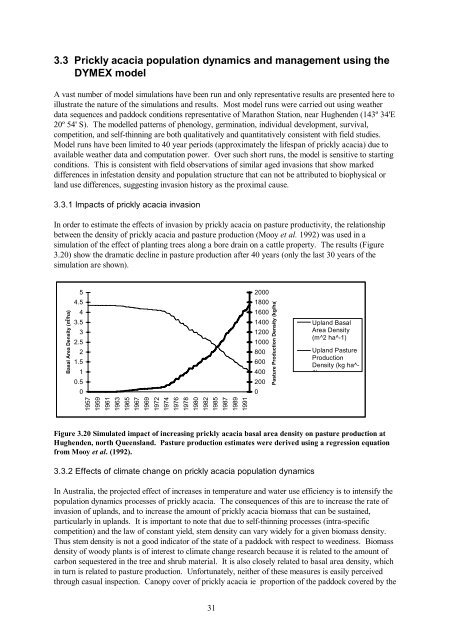EXOTIC WOODY WEEDS Use of simulation models to predict future ...
EXOTIC WOODY WEEDS Use of simulation models to predict future ...
EXOTIC WOODY WEEDS Use of simulation models to predict future ...
You also want an ePaper? Increase the reach of your titles
YUMPU automatically turns print PDFs into web optimized ePapers that Google loves.
3.3 Prickly acacia population dynamics and management using the<br />
DYMEX model<br />
A vast number <strong>of</strong> model <strong>simulation</strong>s have been run and only representative results are presented here <strong>to</strong><br />
illustrate the nature <strong>of</strong> the <strong>simulation</strong>s and results. Most model runs were carried out using weather<br />
data sequences and paddock conditions representative <strong>of</strong> Marathon Station, near Hughenden (143º 34'E<br />
20º 54' S). The modelled patterns <strong>of</strong> phenology, germination, individual development, survival,<br />
competition, and self-thinning are both qualitatively and quantitatively consistent with field studies.<br />
Model runs have been limited <strong>to</strong> 40 year periods (approximately the lifespan <strong>of</strong> prickly acacia) due <strong>to</strong><br />
available weather data and computation power. Over such short runs, the model is sensitive <strong>to</strong> starting<br />
conditions. This is consistent with field observations <strong>of</strong> similar aged invasions that show marked<br />
differences in infestation density and population structure that can not be attributed <strong>to</strong> biophysical or<br />
land use differences, suggesting invasion his<strong>to</strong>ry as the proximal cause.<br />
3.3.1 Impacts <strong>of</strong> prickly acacia invasion<br />
In order <strong>to</strong> estimate the effects <strong>of</strong> invasion by prickly acacia on pasture productivity, the relationship<br />
between the density <strong>of</strong> prickly acacia and pasture production (Mooy et al. 1992) was used in a<br />
<strong>simulation</strong> <strong>of</strong> the effect <strong>of</strong> planting trees along a bore drain on a cattle property. The results (Figure<br />
3.20) show the dramatic decline in pasture production after 40 years (only the last 30 years <strong>of</strong> the<br />
<strong>simulation</strong> are shown).<br />
Basal Area Density (m 2 /ha)<br />
5<br />
4.5<br />
4<br />
3.5<br />
3<br />
2.5<br />
2<br />
1.5<br />
1<br />
0.5<br />
0<br />
2000<br />
1800<br />
1600<br />
1400<br />
1200<br />
1000<br />
800<br />
600<br />
400<br />
200<br />
0<br />
Pasture Production Density (kg/ha)<br />
Upland Basal<br />
Area Density<br />
(m^2 ha^-1)<br />
1957<br />
1959<br />
1961<br />
1963<br />
1965<br />
1967<br />
1969<br />
1972<br />
1974<br />
1976<br />
1978<br />
1980<br />
1982<br />
1985<br />
1987<br />
1989<br />
1991<br />
Upland Pasture<br />
Production<br />
Density (kg ha^-<br />
1)<br />
Figure 3.20 Simulated impact <strong>of</strong> increasing prickly acacia basal area density on pasture production at<br />
Hughenden, north Queensland. Pasture production estimates were derived using a regression equation<br />
from Mooy et al. (1992).<br />
3.3.2 Effects <strong>of</strong> climate change on prickly acacia population dynamics<br />
In Australia, the projected effect <strong>of</strong> increases in temperature and water use efficiency is <strong>to</strong> intensify the<br />
population dynamics processes <strong>of</strong> prickly acacia. The consequences <strong>of</strong> this are <strong>to</strong> increase the rate <strong>of</strong><br />
invasion <strong>of</strong> uplands, and <strong>to</strong> increase the amount <strong>of</strong> prickly acacia biomass that can be sustained,<br />
particularly in uplands. It is important <strong>to</strong> note that due <strong>to</strong> self-thinning processes (intra-specific<br />
competition) and the law <strong>of</strong> constant yield, stem density can vary widely for a given biomass density.<br />
Thus stem density is not a good indica<strong>to</strong>r <strong>of</strong> the state <strong>of</strong> a paddock with respect <strong>to</strong> weediness. Biomass<br />
density <strong>of</strong> woody plants is <strong>of</strong> interest <strong>to</strong> climate change research because it is related <strong>to</strong> the amount <strong>of</strong><br />
carbon sequestered in the tree and shrub material. It is also closely related <strong>to</strong> basal area density, which<br />
in turn is related <strong>to</strong> pasture production. Unfortunately, neither <strong>of</strong> these measures is easily perceived<br />
through casual inspection. Canopy cover <strong>of</strong> prickly acacia ie proportion <strong>of</strong> the paddock covered by the<br />
31

















